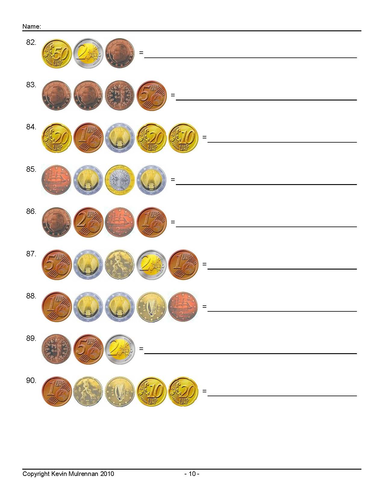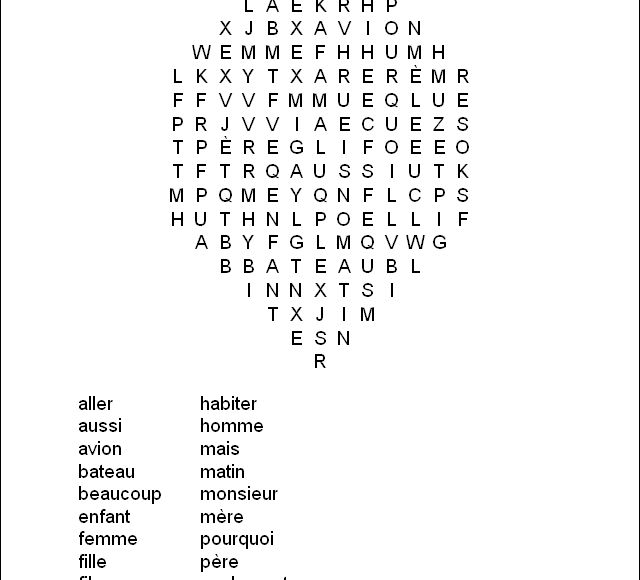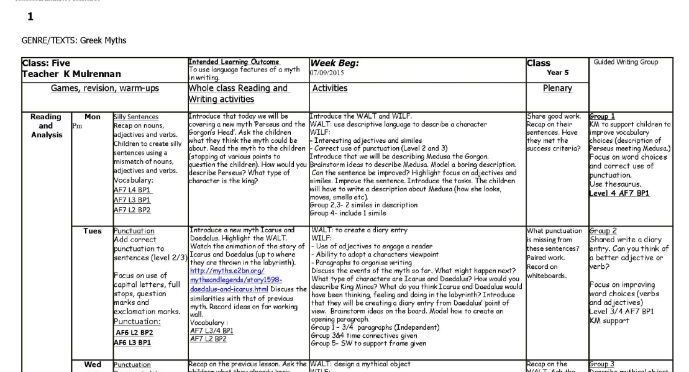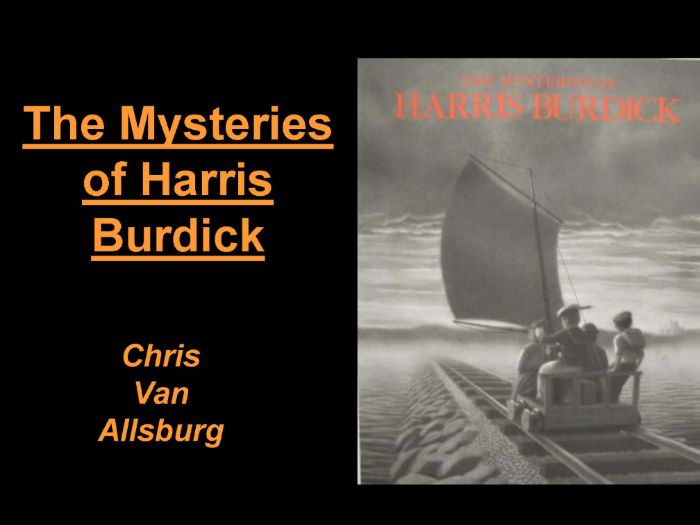404Uploads
119k+Views
40k+Downloads
Languages

Freebie 2 French Wordsearches KS1 KS2 Perfect for Friday Afternoons With Answers
2 French wordseaches with answers.
Each one has 20 basic words to find.
Perfect for rainy Friday afternoons, homeworks etc.
If you like these, please visit my shop where you can purchase 500 of these at a very reasonable price.

Euro Coins Worksheets KS1 KS2 Mathematics Freebie
A worksheet that pupils have to fill in. They have to add up the coins.
If you like it, please visit my shop that has an enhanced similar product.

Christmas Year 6 Planning With Emphasis on Comparison of Gospels
Great planning.
Powerpoints and worksheets plus a week plan.
sample planning :
Ask children to think about their literacy lessons – TTYP and name the important details that are needed in telling a story
(e.g. time, place, characters and events).
Ask children to the recall names of the four main Gospels.
Do they all tell the same story? (Essentially yes but lead children towards idea that they are different versions of the same story).
Use analogy of an incident occurring on the playground – would each child tell the same incident in the same way? No they would tell their version of the same event – some details and word choices would differ.
Talk about today’s WALT and explain that we are going to be looking at some different Gospel accounts of the birth of Jesus Christ. Explain to ch that, in order to achieve their WALT, they will need to be comparing and contrasting everything which they read.
Explain briefly that three out of the four Gospels deal with the birth or Christ; there are many similarities and many differences in the way in which the Gospels record and explain the event.
For today’s lesson we are going to focus on Matthew’s Gospel and Luke’s Gospel.
Discuss possible reasons for the differences in the two accounts. They are coming from two different people; points of view; written at different times but the basic story is the same.
Briefly recap last lesson. Which two Gospels did we look at? Which story were we reading? Did both Gospels tell the story in exactly the same way?
Refer to the list which was made in the plenary last lesson - which other characters were involved in the Christmas story?
Re-read the story of the birth of Jesus in Matthew’s Gospel. Continue to read until Chapter 2 verse 12.
Why did the message of Jesus’ birth first come to shepherds rather than King
Herod?
Why did Herod want to get rid of Jesus?
What words would you use to describe the threat that this baby was to Herod?
What do you think led men to come from the east by the light of a star to find this child?
Herod assumed the King of the Jews sought by the wise men was a conventional king and thus a rival to his throne.
TTYP – what were the names of the three gifts which the wise men brought to the baby Jesus?
Briefly recap the unit so far. Who are the main characters in the Christmas story? Which two Gospel accounts of the birth of Christ have we looked at? What are the similarities and differences between them?
Share the WALT and explain that this lesson will focus on the birth of Christ according to St John’s Gospel.
Explain that in St. John’s Gospel there is no account of the birth of Christ, but there is a poem at the beginning that speaks about him.
Use PPT to explain a prologue.

Easter Lessons Through Literature Planning Powerpoints Worksheets Road To Emmaeus
Materials for teaching Easter and Jesus and his disciples.
Planning powerpoints etc.
Road to Emmaeus board game.

Christmas assembly Script Ten Pages
ten page script.
Nice piece you can perform in class or to an assemlbly.
sample :
Narrator: Welcome to our Christmas celebration!
Narrator Welcome to INSERT TOWN, where our journey begins!
Narrator: Picture our winter scene…
Narrator: The air is filled with excitement, the faint hum of an inflatable Santa, blinding Christmas lights line the streets, illuminating the December skies.
Narrator: Our story begins in a beautifu; house not too far away from here…
Narrator: It is a tale of sadness, humour and love. If you are young or old, our story is one you will love!
Narrator : Oh no it isn’t!
Narrator: Oh yes it is! So sit back and enjoy the show, a magical tale of a young girl called Cinderella.
Narrator: It’s December 23rd. A bitterly cold winter’s eve. Across the globe people were making last minute plans for Christmas festivities.
Narrator: People running frantically from shop to shop to get their last minute presents.
DANCE: SHOPPING BAGS AND PRESENTS (Christmas Wrapping)
Narrator: Cinderella was busy vacuuming, cooking the dinner, ironing (funny mime of Cinderella doing different jobs all at once!) and washing,…… when something caught her eye…

Literacy Planning Year 6 English Newspaper Reports Instructional Writing
77 files in total.
The preview gives you an idea of the flavour.
Sample planning: Reading as a Reader
Introduction
Discuss the purpose of instructions, what could they be used for? Allow the children to discuss for 1 minute the different types of instructions that there are that they know of. Take feedback and write on spider diagram. Inform the children that they are going to be going through several types of instructions over the next couple of days and analysing them as a reader. What made them successful for them, what they would have done differently etc.
Main Activity
Discuss the ‘Witches Fingers Recipe’ with the children, What do they notice straight away that is useful for us as readers? Annotate on WB.
Inform them that we are now going to create these treats reflecting on the information provided and how useful it was for us as readers.
Split the class into 2 groups - Create the treats – discussing the instructions as they go along.
Ask the children to complete the reflection sheet in pairs.
Discuss the instructions with the children and their reflection sheets, what made them successful? What would they have done better? Why? How would it have changed these instructions?
Were the children ablet o follow the instructions?
Were they able to evaluate the effectiveness of these instructions as a reader?
Were they able to identify some of the key features that made them effective, such as the layout etc?
Introduction
Remind the children that they are evaluating instructions as a reader. Inform them that today, they are going to be evaluating different card game instructions and their effectiveness. Also that we are not to support them, as they need to evaluate them themselves and they are going to tell me whether they were effective instructions at the end of the lesson and why.
Main Activity
Children are to be in mixed ability reading pairs, read through the instructions and follow the instructions independently and play the card games. Carousel the pairs to the different games, allowing them 10 minutes at each activity.

500 French Wordsearch KS1 KS2 Friday Afternoon Treat Homework France Wordsearch
A zip file containing 500 French wordsearches I’ve designed.
All answers provided.
10 sets of simple words. 50 different shapes.
A big file so please be patient when downloading.
Ideal for Friday afternoons, homeworks, fun etc.
Each worksheet has 20 French words to find.

108 Cloze Exercises Aesop's Fables KS1 KS2 Literacy Greek Roman Myths Aesop
108 cloze exercises on Aesop’s Fables.
Great for Literacy lessons. Gives lower ability pupils confidence.
The Cloze worksheet is a standard exercise for improving students’ understanding of word context.
The student then fills in the words on the worksheet based on an understanding of the sentence and the list of potential words removed from the text.
The cloze procedure is a reading comprehension activity in which words are omitted from a passage and students are required to fill in the blanks. This procedure is incredibly useful in reading instruction because it can be easily done by any teacher and provides valuable reading comprehension information.

Year 5 Literacy Planning Autumn Term KS2 Greek Myths Big Write
This is a zip file containing Literacy planning for a year 5 class (Autumn term)
It consists of 14 short term plans I designed. There is one Literacy lesson per day.
You will get 14 Microsoft Word documents. They are based on the Greek myths.
I’ve also included for free some extra teaching materials that you can use. I’ve included too 3 medium term plans , one for each term). These cover plans and ideas not just for Literacy, but other subjects as well.
I’ve also included an extra week from the next term. Feel free to use it to plug any gaps.
This will help you do your own planning. Feel free to cut and paste into your own school’s plans.
Ideal for someone who had to do a term’s supply like I had to do.
Please bear in mind:
every school is different. My plans assume you have the aide of a TA, but this is not essential. There is no differentiation in the planning. Everyone does the same thing to the best of their ability.
you may want to add your own detail. These are short term plans remember.
I have used walts and wilts. Your school may do something different.
A very few number of weeks have a small gaps for things like tests and inset days. Use the extra week one planning for the next term (included for free) if you wish.
Bundle

Year 3 and Year 4 Complete Year's Planning Numeracy Literacy KS2 plus Mathematics Aesop Cloze Test Worksheets
Mega bundle.
Please look at my shop for full details.
Complete year’s planning for Year 3 and Year 4 plus:
Telling the time worksheets
Times Tables worksheets
Aesop close test worksheets
All answer sheets provided for worksheets.
Great value. Please be patient when downloading.

European Day Of Languages Powerpoints France Spain Italy
For the European day of languages, but can be used anytime.
Useful info on France, Spain, Italy, Greece, Germany, Sweden and Wales.
Brilliant for assemblies.
Great value as there is a lot of stuff.

Morning Work Sentence Uplevelling Work Literacy Year 5 Pie Corbett
Some easy worksheets to get pupils uplevelling.
Good exercise to have on the desk when they arrive in class.
Plus some nice VCOP and Pie Corbett stuff.
Improving Sentences Checklist:
improve the verb
add an adjective (WOW word)
extend with a connective
start with an ly, ed or ing word
include a simile or a metaphor
add an adverbial
Sentence up Levelling
There was a volcano There were sparks flying
Molten lava streamed down the sides

Back to School Autumn Term Year 5 Full Planning Worksheets
Some terrific planning. The last I did before retirement.
It covers the whole of the Autumn term for year 5.
It concentrates on Maths and English. But loads extra on the arts and humanities and pe.
Sample planning
To apply understanding of the structure of a Greek Myth to identify separate parts of a myth
I can order key events in a quest
I can identify how the events in a quest are separated by the writer, referring to the structure/content of the text
I can identify key language features of Greek Myth Texts
Starter
Read “The 12 Labours of Heracles” to the children (58-66, The Orchard Book of Greek Myths).
Recap features of quest – ask chn to identify these
• A quest is a journey towards a goal, which usually requires great effort by the hero/heroine.
• They need to overcome many obstacles, and it usually involves a lot of travel.
• The hero normally tries to obtain something or someone through the quest, and then take this home. The object can be something new (golden fleece), something to fulfill a lack in their life, or to return something that was stolen from the hero or from someone with the power to send them on the quest.
• If someone dispatches the hero on a quest, the reason may be false -Hero sent on a difficult quest in hope that they die, or in order to remove them from the scene for a time.
• Tale usually ends with the dispatcher being unmasked and punished.
• There may be a twist at the end of the tale, to punish any misdeeds of the hero/heroine, or because one of the Gods is displeased by the successful conclusion of the quest.
MAIN ACTIVITY (Resources; boxed table)
Split chn into groups and give them a Greek Myth text. Ask chn to box up text: Chn can draw/write about important places and events on the quest, and should quote words that show the passing of time. CT to model boxing up method for 1st event in “Heracles” text and identify how scene was set, by the writer.
This activity requires children to identify details for the following sections, for EACH event on the quest:
EVENT 1
• Setting
• Obstacle (Elements of danger/safety at setting/ on the journey)
• Any words used to show time has passed
• Overcoming obstacle

Year 3 Maths English Planning Topic work on China
English and maths planning. 39 files
Text: ARCHIES WAR – Marcia Williams
Genres covered in this unit: 2 weeks - character descriptions – to include descriptive settings
Letter writing, information texts and propaganda posters.
Children have white boards. I will describe a person and you must draw them From the twits Roald dahl(Mr Twits). Children share ideas from the first opening paragraph. What made this so visual. LANGUAGE
Look at a series of images. Witch, doctor, pirate.
Look at the features, are there similarities.
Elaborated pictures of people. Famous and non famous.
Discussion and focal point.
Play head band with the children. They have to describe the person they are holding and the partner has to guess who it is.
Expanding on words to describe Steps to Success
Mild: To review characters
Spicy: To recognise features of a character
Hot: To describe your character
Extra Hot: How could you describe yourself? Tell me.

Spring Term Literacy Planning Year 5 s1 KS2
Great planning for year 5 for the Spring Term.
Jam packed with plans, ideas, powerpoints etc.
You get 200 mb of material, so great value. e.g. Persuasive writing, recounts, stories from other cultures, descriptive writing, model writing
Plus you get some year 5 Autumn planning I did in one school I taught in.

RE Christmas lesson Four Powerpoint and Planning Catholic Flavour
Lesson four in my nice Christmas unit.
Please look at the others to get the idea.
Nice powerpoint ion this one.

English year 5 and 6 The Mysteries of Harris Burdick Planning and Powerpoints Literacy year 5
A great collection for teaching this interesting topic.
You get powerpoints and planning.
Sample :
Punctuate sentences accurately, including using speech marks and apostrophes.
Use commas to mark clauses.
Group and classify words according to their type and meaning.
Read a variety of texts, commenting on the author’s choice of vocabulary.
Construct sentences which are punctuated correctly; including the use of commas, speech marks and apostrophes.
Use a range of connectives to join sentences.
Experiment with complex sentences.
Whole Class Shared Learning
Discuss pronouns (homework)
Define each type of word: Noun, adjective, verb and adverb. Build up a sentence as we go.
Show the children a picture on the whiteboard of a horse galloping and of a lightning bolt. Children to write down 3 (LA) or 5(MA and HA) important nouns from the picture. Share. On the left of the noun, children to write an adjective to modify or describe the noun. Share. After the noun, children to write a verb and then an adverb to qualify the verb.
e.g. The black horse galloped elegantly along the beach.
Praise the children on yesterday’s literacy work – they showed knowledge of the function of nouns, adjectives, verbs and adverbs (HA showed knowledge of the difference between common, proper and pro nouns).
Children to name a range of punctuation – I record on the board (I do not add to it at this point).
Ask volunteers to illustrate uses of the punctuation named. Look on the punctuation pyramid – have we named any L5 punctuation? This is what we should be aiming at all the time.
Children to have a variety of sentences to up level punctuation on their whiteboards.
Come back to ‘The Mysteries of Harris Burdick’. Read through all of the captions and talk about ‘reading’ the illustration. Allow children time to talk about the ‘mystery’ – what do they think happened to Harris Burdick?
Choose a picture from ‘The Mysteries…’ and list all of the questions which it provokes. What do children think of the pictures? Do the captions answer any of the questions?
Talk about the settings in the pictures – often they are recognisable, familiar settings where things are not as they seem. Explain that we would call this ‘Stories in a familiar setting’.
Model the task.
Use PPT to study speech punctuation.
Use the pictures from ‘The Mysteries…’ to write some possible dialogue.
Model possible conversations, including synonyms for said and adverbs plus adverbial clauses. With correct punctuation.
Look at some of the pictures from ‘The Mysteries …’
Think / discuss some of the characters in the pictures. Use adjectives to describe them – give them names. From the pictures come up with verbs to describe what they are doing then add adverbs and adverbial clauses.

Shakespeare Week Lesson Plan For Year 6 Literacy Drama
Suitable for year 6.
Worked very well for me.
For instance the first day :
Grammar Starter
L.O: Know one of Shakespeare’s stories.
Success Criteria
Know some background information about William Shakespeare, his time and his work.
Describe the basic plotline of ‘A Midsummer Night’s Dream’
Start to talk about the main characters; their hopes, desires and challenges.
Main teaching:
Who was William Shakespeare?
Use above website to read about his background – note that he wrote plays – his works were intended to be acted.
Use the above website to look at the list of plays – discuss terms tragedy, comedy and historical play.
Read ‘A Midsummer Night’s Dream’ shortened, story version. Explain that this was written in 1595.

Ash Wednesday Lent Teaching Resources Planning Powerpoints Worksheets Religion
I taught in Catholic schools for years.
Now happily retired, I have assembled all my planning for Lent.
Packed full of stuff. Powerpoints, planning, worksheets, masses etc etc.
This will really make your life easy.
Over 300 mb of stuff. Nearly 500 files.
Sample planning :
PRAYER Start with prayer, light candle, music – look at and reflect on the temptations of Jesus.
INTRODUCTION
Read the text of the temptations of Jesus. Why was Jesus in the desert in the first place? What had just happened to him before this episode in his life?
Recall the three things the devil asked Jesus to do.
What was Jesus’ response on each occasion?
Why do you think these three things were chosen to tempt Jesus?
Jesus was as human as you and me, in all but sin, and yet at the same time he was Gods’ Son.
Do you really think it was difficult for him to say no to the devil? Why do you think it might have been difficult?
Look at the text again. Are there any indicators, which show that this was easy?
MAIN ACTIVITY
Imagine you are Jesus. Write a diary entry about the temptations and how it affected you.
LA to use writing frame
MA to work with partners and write a diary entry about the temptations and how it affected them.
HA to work independently and write a diary entry about the temptations and how it affected them. They will need to also discuss the different responses given by Christ.
Assistant to support LA group. TA n/a
PLENARY AND PRAYER
Reflect on the temptations of Jesus in the desert.
End with prayer – reflect on Jesus’ response to the devil.
PRAYER Start with prayer, light candle, music – look at and reflect on
the temptations of Jesus.
INTRODUCTION
Using the following:
read the text of the temptations of Jesus.
In groups, children to brainstorm the word “temptation” and create a mind map of associated words. What is it like when you are tempted to do something you shouldn’t?
How can we tell the difference between doing something that is right or wrong?
How can we resist the things that are wrong?
MAIN ACTIVITY
Children to write of a time when they resisted temptation or when somebody gave into temptation. Explore the consequences of the different actions.
LA to use writing frame
MA to work with partners and write of a time when they resisted temptation
HA to work independently and write of a time when they resisted temptation and when they gave into temptation. They will need to explore the consequences of the different actions.
Mr Mayor to support LA group
TA n/a
PLENARY AND PRAYER
Reflect on the difference between doing something that is right and something wrong.
End with prayer – reflect on how we can resist the things that are wrong.

Back To School French Primary School Resources and Lessons
Have you been volunteered (know what I mean?) to deliver Modern Languages at your Primary School?
This bunch of resources, that I used in my decades of French teaching, will help.
I’ve put them into groups to help you.
the zip file has loads. I’ve put a selection as downloads so you can have a look at them.
Highlights include:
festivals
games and activities
how to
ideas for lessons
phonics
poems
loads of powerpoints
songs
stories




















